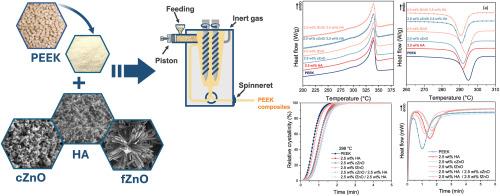羟基磷灰石/氧化锌PEEK纳米复合材料结晶动力学:纳米颗粒形态和杂化的影响
IF 4.5
2区 化学
Q2 POLYMER SCIENCE
引用次数: 0
摘要
本研究探讨了羟基磷灰石(HA)和氧化锌(ZnO)增强聚醚醚酮(PEEK)纳米复合材料的等温和非等温结晶行为,重点研究了填料形貌和杂化的作用。采用差示扫描量热法(DSC)结合Avrami分析研究了不同温度下的结晶动力学。传统的纳米填料通常由于阻碍链迁移而延迟结晶,而加入2.5% wt.%的花状ZnO (fZnO)显著减轻了这种影响,显示出与纯PEEK相当的结晶行为。相反,球形ZnO (cZnO)、HA及其杂化体系导致结晶时间延长。尽管结晶速率发生了变化,但熔化温度(Tm)和平衡熔化温度(Tm0)几乎没有变化,表明层状厚度保持不变。结果表明,纳米颗粒的形貌对成核动力学有很大的影响,而fZnO提供了一种有前途的策略,可以在不影响晶体结构的情况下定制结晶。这些发现为设计用于结构和生物医学应用的高性能peek基材料提供了关键见解。本文章由计算机程序翻译,如有差异,请以英文原文为准。

Crystallization kinetics of PEEK nanocomposites with hydroxyapatite and zinc oxide: influence of nanoparticle morphology and hybridization
This study explores the isothermal and non-isothermal crystallization behavior of poly(ether ether ketone) (PEEK) nanocomposites reinforced with hydroxyapatite (HA) and zinc oxide (ZnO), with emphasis on the role of filler morphology and hybridization. Differential scanning calorimetry (DSC) combined with Avrami analysis was employed to investigate crystallization kinetics at multiple temperatures. While conventional nanofillers generally delay crystallization due to hindered chain mobility, the incorporation of 2.5 wt.% flower-like ZnO (fZnO) significantly mitigated this effect, showing crystallization behavior comparable to neat PEEK. In contrast, spherical ZnO (cZnO), HA, and their hybrid systems led to extended crystallization times. Despite variations in crystallization rate, melting temperature (Tm) and equilibrium melting temperature (Tm0) remained nearly unchanged, indicating preserved lamellar thickness. The results highlight that nanoparticle morphology strongly influences nucleation dynamics, and fZnO offers a promising strategy to tailor crystallization without compromising crystalline structure. These findings provide key insights for designing high-performance PEEK-based materials for structural and biomedical applications.
求助全文
通过发布文献求助,成功后即可免费获取论文全文。
去求助
来源期刊

Polymer
化学-高分子科学
CiteScore
7.90
自引率
8.70%
发文量
959
审稿时长
32 days
期刊介绍:
Polymer is an interdisciplinary journal dedicated to publishing innovative and significant advances in Polymer Physics, Chemistry and Technology. We welcome submissions on polymer hybrids, nanocomposites, characterisation and self-assembly. Polymer also publishes work on the technological application of polymers in energy and optoelectronics.
The main scope is covered but not limited to the following core areas:
Polymer Materials
Nanocomposites and hybrid nanomaterials
Polymer blends, films, fibres, networks and porous materials
Physical Characterization
Characterisation, modelling and simulation* of molecular and materials properties in bulk, solution, and thin films
Polymer Engineering
Advanced multiscale processing methods
Polymer Synthesis, Modification and Self-assembly
Including designer polymer architectures, mechanisms and kinetics, and supramolecular polymerization
Technological Applications
Polymers for energy generation and storage
Polymer membranes for separation technology
Polymers for opto- and microelectronics.
 求助内容:
求助内容: 应助结果提醒方式:
应助结果提醒方式:


